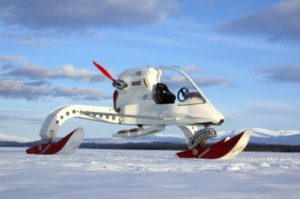The Lotus Ice Concept vehicle was used by the Moon Regan Transantarctic Expedition, which was a fact-gathering mission intended to bring up-to-date data to the public consciousness. It aimed to show how Antarctica’s fate reflects and affects the global environment with respect to climate change. In order to scout out the intended route, searching for hazards and hidden ice crevasses, the expedition used this fascinating creation from Lotus.
The Concept Ice Vehicle (CIV) is 4.5m (14.8 ft) long by 4.5m (14.8 ft) wide, with three independently suspended legs each carrying an oversize ice ski. It’s name was later changed to the The Winston Wong Bio-Inspired Ice Vehicle – the ‘microlite on skis’ was named in honour of the Expedition’s main sponsor Professor Winston Wong, a leading Taiwanese businessman and alumnus and generous donor to Imperial College London.
The propeller engine is designed to operate on standard or eco-frendly bio-diesel, and when the terrain gets too rough for the CIV to cross, it’s light enough to be hauled by one or two people over the bumpy ice surface via a rope.
Braking is another issue – a large, spiked metal arm is forced down into the smooth ice, dragging the CIV to a halt – and it comes equipped with a radar to detect hidden ice crevasses that could spell trouble for the rest of the team.
The ultralight purpose-built concept was designed by former F1 chassis designer Kieron Bradley and polar guide Jason de Carteret.
Led by Andrew Regan and Andrew Moon, the 10-man Moon Regan Transantarctic Expedition team left Union Glacier on 25 November and arrived, via the Geographic South Pole, on the Ross Ice Shelf on 9 December. They then retraced their tracks and completed the return journey on 17 December. In all they covered nearly 4,000 km and travelled for 20 days, 12 hours and 30 minutes.
The Lotus Ice Concept vehicle was the first bio-fuelled vehicle to reach the South Pole and they completed the first there-and-back vehicle crossing of the Antarctic continent,
The team mapped and photographed meteorites for Dr Matthew Genge, from the Department of Earth Science and Engineering at Imperial College London. The large, white, undeveloped expanses of Antarctica make it a prime location for meteorites. These rocks are often older than the Earth itself.
Snow samples were collected over the course of the Expedition and were kept for analysis of trace metal concentrations and Persistent Organic Pollutants (POPs). Trace metals and POPs can be used as markers to show the circulation of pollutants within the Southern hemispheres.
Ground penetrating radar was used to study the surface integrity of the ground in front of the vehicles. The data from the radar will be offered for future crevasse-mapping.
Land-based crossings of the whole Antarctic continent have only been achieved twice. Both expeditions took many months because of the terrain and the type of vehicles used.
Specifications
For those with an interest in the technical side:
Lotus Ice Concept Vehicle
Facts and figures
• Originally developed with an 1150 BMW engine adapted to run on E85 bioethanol. The engine was changed in the run up to the 2010 Expedition to a Rotax 914, which will be better suited to lower temperatures and higher altitude and is proven to deliver more horsepower
• BIV is bio-fuelled. The Expedition monitored the performance of bio-fuel in this harshest of environments
• The BIV has the minimum possible number of moving parts
• It has a three blade variable-pitch propeller
• There are three skis with independent suspension and a spiked brake for efficient stopping
• weight is around 700kgs
• top speed is around 84mph
• size is approximately 4.5 m long and 4.5 m wide
• The BIV carries only one driver. Driving was shared by the 10-man Expedition team over the journey across Antarctica
• light and can be man-hauled if necessary over difficult sastrugi terrain
The Science Support Vehicles (SSVs)
The Expedition used two six-wheel drive Science Support Vehicles. The SSVs carried the team and acted as mobile laboratories for the research being undertaken for Imperial College London.
The Expedition team hoped to demonstrate that wheel-based land vehicles are the best option – and less harmful environmentally than air travel – for long distance travel over frozen terrain. The SSVs are converted Ford Econolines.
Facts and figures for the SSV’s
• All wheels can be independently driven
• Low emission, turbo-charged, fuel-injected, 7.3 litre, V8 diesel engine
• Tyres are 44 inches high and 21 inches wide
• Overall the vehicles are each 6.5 metres long, 2.54 metres wide and 2.52 metres tall
• Each vehicle weighs 4.7 tonnes
• High wattage solar panels powered all scientific equipment on board
• The vehicle carried snow melters to provide water for the crew
Well done team.
For another unusual Antarctic vehicle check out the ‘Venturi’ here

